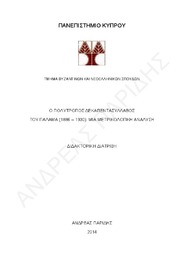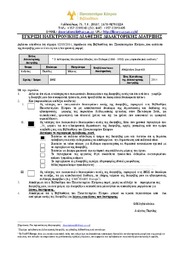| dc.contributor.advisor | Σαμουήλ, Αλεξάνδρα | el |
| dc.contributor.author | Παρίδης, Ανδρέας Μ. | el |
| dc.coverage.spatial | Κύπρος | el |
| dc.coverage.spatial | Cyprus | en |
| dc.creator | Παρίδης, Ανδρέας Μ. | el |
| dc.date.accessioned | 2015-06-22T09:35:37Z | |
| dc.date.accessioned | 2017-07-28T09:25:28Z | |
| dc.date.available | 2015-06-22T09:35:37Z | |
| dc.date.available | 2017-07-28T09:25:28Z | |
| dc.date.issued | 2014-05 | |
| dc.date.submitted | 2014-05-21 | |
| dc.identifier.uri | https://gnosis.library.ucy.ac.cy/handle/7/38955 | en |
| dc.description | Αριθμός δεδηλωμένων πηγών στη βιβλιογραφία: 268 | el |
| dc.description | Διατριβή (Διδακτορική) -- Πανεπιστήμιο Κύπρου, Φιλοσοφική Σχολή, Τμήμα Βυζαντινών και Νεοελληνικών Σπουδών, 2014. | el |
| dc.description | Η βιβλιοθήκη διαθέτει αντίτυπο της διατριβής σε έντυπη μορφή. | el |
| dc.description.abstract | Αντικείμενο της παρούσας διατριβής αποτελεί ο παλαμικός δεκαπεντασύλλαβος καθώς επίσης και τα διάφορα εξελικτικά του στάδια. Η ενδελεχής ανάλυση συγκεκριμένων στατιστικών δεδομένων και αποτελεσμάτων που πραγματοποιείται στη συγκεκριμένη μελέτη επιβεβαιώνει με εξαντλητικές αποδείξεις και αριθμούς τη μεγάλη προσφορά του ποιητή στην ανανέωση του εθνικού μας στίχου. Επιπλέον, μελετώνται και αναλύονται τα ποικίλα μετρικά και ρυθμικά μέσα στο σύνολό τους τα οποία χρησιμοποιεί ο ποιητής στην προσπάθειά του να διασκεδάσει την προϋπάρχουσα ρυθμική μονοτονία του στίχου.Η διατριβή αποτελείται από δύο βασικά μέρη. Το πρώτο μέρος περιλαμβάνει μια σύντομη επισκόπηση μετρικολογικών μελετών και προτάσεων οι οποίες σχετίζονται άμεσα με την περιγραφή τριών βασικών ιστορικών σταθμών του δεκαπεντασύλλαβου: των δημοτικών τραγουδιών, της κρητικής ακμής καθώς και της ποίησης του Σολωμού. Μέσω αυτής της ιστορικής αναδρομής συνοψίζονται τόσο οι ποικίλες μορφές του στίχου όσο και τα στάδια εξέλιξής του πριν από την ανανέωση που επιφέρει σε αυτόν ο Παλαμάς.
Το δεύτερο μέρος της διατριβής αναφέρεται αποκλειστικά στον παλαμικό δεκαπεντασύλλαβο. Αρχίζει με μια συνοπτική παρουσίαση της μετρικής θεωρίας του ποιητή, έτσι όπως αυτή διαμορφώνεται μέσα από τα διάφορα δοκίμια που γράφει καθ’ όλη τη διάρκεια της ενασχόλησής του με τον στίχο, και συνεχίζει με την εξονυχιστική μετρική ανάλυση επτά έργων του, γραμμένων σε ιαμβικό δεκαπεντασύλλαβο. Η μετρική ανάλυση περιλαμβάνει ποικίλα μετρικά φαινόμενα τα οποία εμφανίζονται στα συγκεκριμένα έργα, όπως για παράδειγμα είναι η έντονη παρουσία του φαινομένου της συνίζησης σε συνδυασμό με τα μειωμένα ποσοστά χασμωδίας, οι πυκνοί και έντονοι διασκελισμοί, η υπονόμευση και κατάργηση της μεσαίας τομής του στίχου, τα αναπαιστικά βαδίσματα, οι παρατονισμοί και η έντονη στίξη, καθώς επίσης και κάποιοι μετρικοί νεωτερισμοί, όπως είναι ο «τριμερής» και «σπασμένος» στίχος, τους οποίους χρησιμοποιώντας ο ποιητής ανανεώνει τον στίχο.
Η μετρικολογική ανάλυση διεξάγεται ανά μετρικό φαινόμενο από έργο σε έργο με χρονολογική σειρά. Η σειρά εξέτασης και παρουσίασης του κάθε φαινομένου σχετίζεται με τον βαθμό σημασίας και βαρύτητας που έχει για τον στίχο. Τα δύο κύρια μέρη της διατριβής ακολουθεί Παράρτημα πινάκων, στους οποίους καταγράφονται τόσο τα ρυθμικά σχήματα, όσο και τα μετρικά φαινόμενα που εμφανίζονται στους παλαμικούς στίχους, καθώς επίσης και η συχνότητα εμφάνισής τους.
Η μελέτη αυτή αποδεικνύει ξεκάθαρα την οριακή επεξεργασία την οποία υφίσταται ο δεκαπεντασύλλαβος από τον Παλαμά, ο οποίος εκμεταλλεύεται σωστά τόσο την εγχώρια ποιητική παράδοση, όσο και την ξένη στιχουργία. Ο στίχος στο απόγειό του χαρακτηρίζεται από μια σειρά καινοτομιών, δοκιμασμένων τεχνικών και τολμηρών στιχουργικών αναχρονισμών, που υπερβαίνουν τόσο τα ρυθμικά πρότυπα της παράδοσης, όσο και εκείνα της ποίησης της εποχής του Παλαμά. Ο ποιητής, μέσα από μιαν αδιάκοπη δουλειά μιας ολόκληρης ζωής, δημιουργεί έναν εντελώς ξεχωριστό και προσωπικό δεκαπεντασύλλαβο. Η μοναδικότητα του στίχου αυτού αποδίδεται σε μεγάλο βαθμό στη συστηματική και εντατική χρήση των διαφόρων μετρικών και ρυθμικών μέσων, τα οποία αποδεικνύουν περίτρανα τη μεγάλη στιχουργική ικανότητα του ποιητή. | el |
| dc.description.abstract | Aim of the present thesis is the fifteen-syllable verse of Palamas, as well as, its various evolutionary stages. The thorough analysis of certain statistical data and results realized in the present study confirms, with a great number of pieces of evidence and numbers, the great offer of the poet to the renewal of our national verse. In addition, all the various metrical and rhythmical means, which the poet uses in his effort to change the previous rhythmical monotony of the verse, are studied and analyzed.
The thesis consists of two basic parts. The first part includes a short review of the metrical studies and proposals, which are directly related to the description of three basic historical landmarks of the fifteen-syllable verse: the folk songs, the literature of Cretan Renaissance, and the poetry of Solomos. Through this historical retrospection, the various forms of the verse, as well as, the stages of its evolution prior the renewal that had been brought about by Palamas, are summarized.
The second part of the thesis refers, exclusively, to the fifteen-syllable verse of Palamas. It starts with a short presentation of the metrical theory of the poet, the way it is formed through the various essays he writes while he was occupied with the verse and it continues with a detailed metrical analysis of seven of his works, written in iambic fifteen-syllable verse. The metrical analysis includes various metrical phenomena, which appear in these works, like the strong presence of the phenomenon of synizesis combined with the reduced percentage of hiatus, the frequent and intensive enjambments, the undermining and abolishing of the mid-line caesura, the anapaestic feet, the wrenched accents and the intense punctuation, as well as, some metrical innovations, like the tripartite lines and the broken verse, which the poet uses to renew the verse.
The metrical analysis is conducted for each metrical phenomenon in all the works under study, in a chronological order. The order, by which, each phenomenon is examined and presented is related to the degree of importance and weightiness it has in the verse. The two main parts of the thesis follows an appendix with tables, in which the rhythmical forms and the metrical phenomena, which appear in the verses of Palamas, are presented, as well as, the frequency by which they appear. This study, clearly proves the thorough analysis, which the fifteen-syllable verse has undergone by Palamas, who takes advantage, in the right way, the local poetic tradition, as well as, the foreign versification. The verse, at its peak, is marked by a series of innovations, tested techniques and bold verse anachronisms, which exceed the rhythmical standards of the tradition, as well as, those of the poetry during Palamas’s era. The poet, through a continuous lifetime work, creates an entirely exceptional and personal fifteen-syllable verse. The uniqueness of this verse is attributed, to a high degree, to the systematic and intensive use of the various metrical and rhythmical means, which prove beyond any doubt, the great versifying ability of the poet. | en |
| dc.format.extent | viii, 329 σ. : εικ. ; 30 εκ. | el |
| dc.language.iso | gre | en |
| dc.publisher | Πανεπιστήμιο Κύπρου, Φιλοσοφική Σχολή / University of Cyprus, Faculty of Letters | |
| dc.rights | info:eu-repo/semantics/openAccess | en |
| dc.rights | Open Access | en |
| dc.subject.lcsh | Παλαμάς Κωστής 1859-1943 Κριτική και ερμηνεία | el |
| dc.subject.lcsh | Greek poetry, Modern History and criticism | en |
| dc.title | Ο πολύτροπος δεκαπεντασύλλαβος του Παλαμά (1886-1930) : μια μετρικολογική ανάλυση | el |
| dc.title.alternative | “The ‘πολύτροπος’ fifteen-syllable verse of Palamas (1886-1930): a metrical analysis” | en |
| dc.type | info:eu-repo/semantics/doctoralThesis | en |
| dc.contributor.committeemember | Σαμουήλ, Αλεξάνδρα | el |
| dc.contributor.committeemember | Πιερής, Μιχάλης | el |
| dc.contributor.committeemember | Βουτουρής, Παντελής | el |
| dc.contributor.committeemember | Κατσιγιάννη, Άννα | el |
| dc.contributor.committeemember | Βογιατζόγλου, Αθηνά | el |
| dc.contributor.committeemember | Samuel, Alexandra | en |
| dc.contributor.committeemember | Pieris, Michalis | en |
| dc.contributor.committeemember | Voutouris, Pantelis | en |
| dc.contributor.committeemember | Katsigianni, Anna | en |
| dc.contributor.committeemember | Vogiatzoglou, Athina | en |
| dc.contributor.department | Πανεπιστήμιο Κύπρου, Φιλοσοφική Σχολή, Τμήμα Βυζαντινών και Νεοελληνικών Σπουδών | el |
| dc.contributor.department | University of Cyprus, Faculty of Letters, Department of Byzantine and Modern Greek Studies | en |
| dc.subject.uncontrolledterm | ΚΩΣΤΗΣ ΠΑΛΑΜΑΣ | el |
| dc.subject.uncontrolledterm | ΔΕΚΑΠΕΝΤΑΣΥΛΛΑΒΟΣ | el |
| dc.subject.uncontrolledterm | ΜΕΤΡΙΚΗ ΑΝΑΛΥΣΗ | el |
| dc.subject.uncontrolledterm | ΜΕΤΡΙΚΗ ΘΕΩΡΙΑ | el |
| dc.subject.uncontrolledterm | ΠΟΛΥΤΡΟΠΟΣ ΣΤΙΧΟΣ | el |
| dc.subject.uncontrolledterm | KOSTIS PALAMAS | en |
| dc.subject.uncontrolledterm | FIFTEEN SYLLABLE VERSE | en |
| dc.subject.uncontrolledterm | METRICAL THEORY | en |
| dc.subject.uncontrolledterm | METRICAL ANALYSIS | en |
| dc.identifier.lc | PA5610.Π34Ω876 2014 | en |
| dc.author.faculty | Φιλοσοφική Σχολή / Faculty of Letters | |
| dc.author.department | Tμήμα Βυζαντινών και Νεοελληνικών Σπουδών / Department of Byzantine and Modern Greek Studies | |
| dc.type.uhtype | Doctoral Thesis | en |
| dc.rights.embargodate | 2017-05-21 | |


